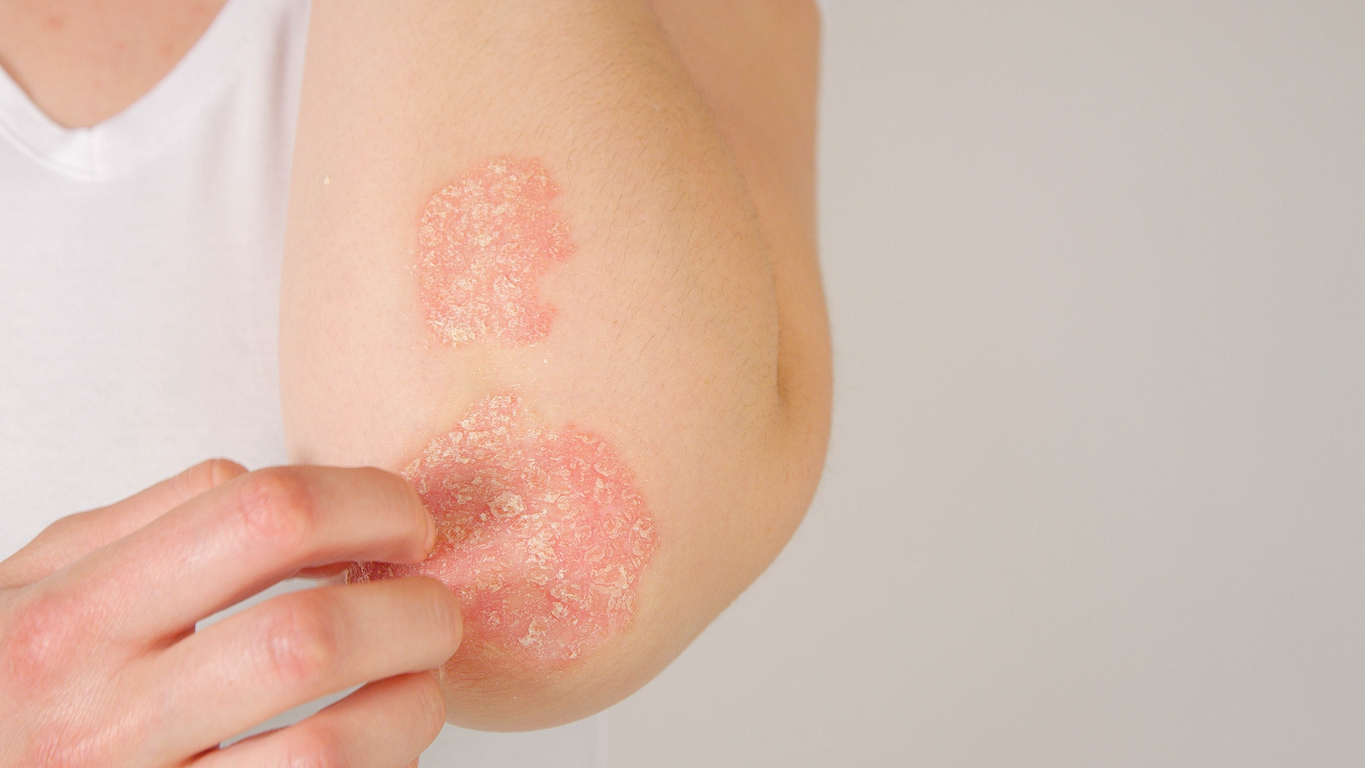Psoriasis and Diabetes: What’s the Connection?
By Alexandra Frost
 Diabetes increases the likelihood of psoriasis, a condition that causes patches of itchy, dry skin, but there are treatments available.
Diabetes increases the likelihood of psoriasis, a condition that causes patches of itchy, dry skin, but there are treatments available.
As with so many frustrating things about life with diabetes, some conditions increase the likelihood of diabetes, while diabetes increases the likelihood of others. Psoriasis, a skin condition, is one of them.
Both of these conditions are risk factors for the other, which means people with diabetes are more likely than the general population to develop psoriasis. The good news is that, according to experts, psoriasis is a common and manageable condition.
What is psoriasis?
Sometimes confused with eczema, psoriasis is actually an autoimmune disease, meaning it results from an abnormal immune system response. The immune system is a complex network of organs, cells, and proteins that defend against infections from bacteria and viruses while protecting the body's own cells.
People with psoriasis might experience scales or what are called raised plaques on their skin, which can look different based on varying skin types. The elbows, knees, and scalp are common locations where psoriasis plaques crop up.
“People with diabetes are at increased risk for many skin conditions, not just psoriasis,” said Dr. John Browning, a board-certified pediatrician, dermatologist, and pediatric dermatologist based in Texas. “It is part of the metabolic syndrome (obesity, hypertension, dyslipidemia, and insulin resistance).”
Browning said the condition is most common in people with type 2 diabetes. Although psoriasis is often seen in adults with diabetes, he’s seeing a surge in the skin condition in children with type 2 diabetes, pointing to the obesity epidemic as the cause.
While psoriasis might not sound too serious, the skin condition can lead to further complications, said Dr. Lindsey Bordone, assistant professor of dermatology at Columbia University.
“For people with diabetes who experience itchy skin where they have psoriasis plaques, simple breaks in the skin from scratching can lead to an increased risk for infection due to bacteria introduced from under the nails,” Bordone said.
In addition, high blood glucose and insulin levels can both affect psoriasis. Insulin, for example, has been shown to have a direct inflammatory effect, Bordone said.
Why is psoriasis more common in people with diabetes?
Like so many other diabetes complications, the impact of high insulin levels due to insulin resistance is a major factor. One 2021 study concluded that insulin resistance may be the underlying link between diabetes and psoriasis.
There is also a relationship between weight gain, inflammation, and skin health for people living with diabetes.
“The severity of psoriasis increases with body mass index. Type 2 diabetes also increases with body mass index,” said Bordone. “Since exercise can be uncomfortable for those with moderate to severe psoriasis, this leads to further weight gain and places patients at an increased risk of type 2 diabetes or exacerbates their diabetes if already present.”
What psoriasis treatments are available for people with diabetes?
Like most skin conditions, getting to the root cause is key in treating psoriasis, rather than responding to the symptoms alone.
Browning said some immunosuppressive agents, such as methotrexate or cyclosporine, can be difficult for people with diabetes to use as they’re already at high risk for liver and kidney disease.
“Newer medications are safer and more effective for people with diabetes,” he said. He also pointed to treatment plans that combine skin, diabetes, and body weight interventions together.
“As more medications become available that decrease insulin resistance and reduce body weight, we’ll see fewer complications of diabetes on the skin,” Browning said. “It’s important to control psoriasis with effective therapies so that patients can exercise and avoid being withdrawn. Many of the new medicines also help reduce the risk of psoriatic arthritis.”
Another autoimmune disease, psoriatic arthritis is a type of inflammatory arthritis (people with psoriasis can develop it, but it can occur in anyone). Finding the right treatment for psoriasis if you have diabetes can be a challenging process of trial and error, and as experts like Bordone mentioned, drug selection can be an issue.
However, the future is bright for treating psoriasis. There is a big push to improve metabolic conditions like excess weight and high blood sugar in patients with psoriasis, Bordone said.
“The newer class of GLP-1 medications have made a big impact in health outcomes for psoriasis patients in both controlling their diabetes and improving their psoriasis due to weight loss,” she said. Examples of effective GLP-1s include Ozempic and Mounjaro.
Experts also point to exercise as a major benefit for people living with psoriasis and diabetes. Walking daily or engaging in other forms of regular exercise is critical for health, Browning added.
Why a team effort is most effective for treatment
Anyone living with diabetes knows that a team of doctors is often involved. In this case, that might include a dermatologist, endocrinologist, primary care physician, and others.
Bordone said she works closely with patients’ endocrinologists to get to the bottom of psoriasis and optimize outcomes. Browning added that this collaboration can be key to identifying less obvious skin conditions like necrobiosis lipoidica or granuloma annulare.
“We all work together to prevent complications from diabetes on the skin, heart, joints, kidneys, and liver,” said Browning. “Often a dermatologist can help diagnose a rare condition that is associated with diabetes, which may even help establish a diabetes diagnosis.”
Though psoriasis can feel complicated and uncomfortable, experts like Browning encourage patients to reach out to their medical team early to get started with a treatment plan that works for them.
Learn more about skin health and diabetes here:








